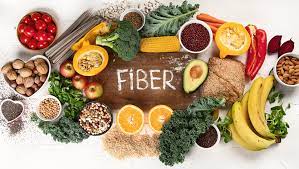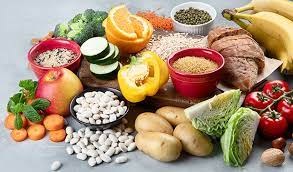It’s no secret that a nutritious diet and regular exercise are the keys to successful weight management. But did you know that consuming enough dietary fiber can also help? Studies have shown that people who get enough dietary fiber are less likely to develop belly fat, which has been linked to an increased risk of metabolic diseases like diabetes and heart disease. In this blog post, we’ll take a look at why fiber is so important for keeping your waistline trim and how you can incorporate more fiber-rich foods into your diet.
Contents
What is Fiber?

When it comes to weight loss, fiber is your best friend. Fiber is a type of carbohydrate that the body cannot digest, so it passes through the system undigested. This makes fiber essential for keeping the digestive system healthy and preventing constipation. Fiber also helps to fill you up and keep you feeling full longer, which can help to reduce calorie intake and promote weight loss.
There are two types of fiber: soluble and insoluble. Soluble fiber dissolves in water and forms a gel-like substance, while insoluble fiber does not dissolve in water. Both types of fiber are important for good health, but soluble fiber is especially beneficial for weight loss. Soluble fiber slows down digestion, which helps you to feel full longer and prevents blood sugar spikes that can lead to cravings and overeating. Good sources of soluble fiber include oats, legumes, fruits, and vegetables.
While all types of fiber are beneficial for weight loss, insoluble fiber has its unique benefits. Insoluble fibers add bulk to the stool, which helps to move food through the digestive system more quickly and prevents constipation. Insoluble fibers also bind with toxins in the intestine and help to remove them from the body. Good sources of insoluble fiber include whole grains, wheat bran, nuts, seeds, and vegetables.
If you’re looking to lose weight or improve your overall health, aim to get 25 grams of fiber per day from a mix of both soluble and insoluble sources. Incorporating more fiber-rich foods into your diet is one of the simplest ways to improve your overall health and reduce belly fat.
Relationship Between Fiber and Belly Fat
Fiber is a type of carbohydrate that the body cannot digest. This means that fiber can help to fill you up without adding any calories or increasing your blood sugar levels.
Studies have shown that people who consume more fiber tend to have less belly fat than those who consume less fiber. One study showed that men who increased their fiber intake by 8 grams per day (equivalent to two slices of whole wheat bread) reduced their visceral (belly) fat by 3 percent over five years.
Another study found that every additional 10 grams of fiber you consume per day is associated with a 3.7 percent reduction in waist circumference.
This relationship is likely because fiber helps slow digestion and keeps you fuller for longer. This can help to reduce cravings and lead to more stable blood sugar levels, which can in turn reduce belly fat.
In addition, fiber may also directly impact the hormones involved in fat storage by increasing satiety hormones and decreasing hunger hormones, leading to less overall calorie consumption.
So if you’re looking to slim down your waistline, make sure you’re getting plenty of fiber in your diet. Good sources of fiber include whole grains, beans, fruits, and vegetables.
How Does Fiber Help With Belly Fat?

Fiber is a type of carbohydrate that the body cannot digest. It passes through the body undigested, helping to bulk up stool and keep you regular. Fiber can also help to regulate blood sugar levels, keeping you feeling fuller for longer and helping to prevent cravings.
Studies have shown that fiber may help to reduce belly fat. One study, in particular, showed that participants who increased their fiber intake by 8 grams per day (the equivalent of two small apples) over five months saw a reduction in visceral fat, the dangerous type of fat that surrounds the organs.
Sometimes, belly fat can be caused by water retention, and fiber is known to help reduce this. It also helps flush out toxins from the body and prevents the accumulation of fats in the intestines. Studies have even shown that consuming a high-fiber diet may help reduce inflammation throughout the body, which could also help reduce belly fat.
To get enough fiber, it’s important to increase your intake of fruits and vegetables, beans and legumes, whole grains, nuts, and seeds. All of these foods are rich in dietary fiber as well as other essential vitamins and minerals that can contribute to overall health. Increasing your daily consumption of fiber may not only help you lose belly fat but will also improve your overall health in many ways.
Foods That Are High In Fiber For Belly Fat
Many foods are high in fiber which can help with belly fat. These include:
Oats
One of the best sources of dietary fiber, oats are a great choice for people looking to reduce belly fat. They also contain a variety of vitamins and minerals that can help promote weight loss. Some of the oats that are highest in fiber are steel-cut oats, rolled oats, and oat bran.
Apples
Apples are a great source of both soluble and insoluble fibers. The skin of the apple is especially rich in dietary fiber, so be sure to include it when eating an apple. Eating apples can help you feel fuller for longer, as well as reduce your risk of certain diseases such as heart disease and type 2 diabetes.
Beans
Beans are a great source of fiber and protein that can help with belly fat. They’re also packed with vitamins and minerals like iron and zinc. Beans come in various forms such as black beans, pinto beans, garbanzo beans, kidney beans, and more.
Berries
Berries such as strawberries, blueberries, raspberries, and blackberries are high in dietary fiber. They also contain antioxidants that can help with reducing inflammation which is associated with excess belly fat. Berries are also a great source of vitamins and minerals like vitamin C, potassium, and magnesium.
Nuts & Seeds
Nuts and seeds contain both soluble and insoluble fiber which can help reduce belly fat. Also, Nuts like almonds, walnuts, cashews, peanuts, and pistachios are all rich sources of fiber. Seeds like chia seeds flaxseeds, and hemp hearts are also excellent sources of fiber that can be added to smoothies or oatmeal for a boost of fiber.
Whole Grains
Whole grains are a great source of dietary fiber and can help reduce belly fat. Also, Whole grain foods include quinoa, oats, brown rice, barley, buckwheat, and bulgur wheat. Eating whole grains is especially beneficial for people looking to lose weight as they can help you stay fuller for longer.
These are just some of the many foods that are high in fiber that can help with reducing belly fat. Adding these foods to your diet along with regular exercise is key to achieving your health goals.
How Much Fiber You Should Eat For Belly Fat?

Most people believe that eating less fat will help them lose weight and reduce their risk of developing obesity-related diseases. However, a growing body of evidence suggests that the opposite may be true—that is, eating more fat may help you lose weight and improve your health.
One type of fat that has received a lot of attention lately is dietary fiber. Fiber is a type of carbohydrate that the body cannot digest. It passes through the digestive system relatively intact and helps to add bulk to stool, which can help with bowel regularity. Fiber has also been shown to have several other health benefits, including reducing inflammation, lowering cholesterol levels, and improving blood sugar control.
Emerging research also suggests that fiber may help with weight loss and waistline reduction. One study showed that people who increased their fiber intake by 8 grams per day (about 2 tablespoons) lost about 4% of their body weight over five years—even without making any other changes to their diet or lifestyle!
So how much fiber should you eat for belly fat? The amount will vary depending on your calorie needs, but most experts recommend getting at least 25 grams of fiber per day. This can easily be accomplished by adding more fruits, vegetables, and whole grains to your diet. So next time you’re looking to trim down your waistline, don’t forget to load up on fiber!
How To Incorporate Fiber For Belly Fat?
Incorporating dietary fiber into your diet is one of the best ways to reduce belly fat. Dietary fiber helps by promoting regular bowel movements, which can help reduce bloating and inflammation in the abdomen. Additionally, high-fiber foods are generally low in calories and contain important nutrients that support a healthy diet.
Getting enough fiber each day can be as simple as adding more fruits, vegetables, legumes, nuts, and seeds to your meals and snacks. Whole-grain bread and cereals are also excellent sources of fiber. If you need additional assistance getting enough fiber for belly fat reduction, consider taking a supplement such as psyllium husk or oat bran to get your daily requirement. Eating more soluble fibers like those found in oats, apples, and citrus fruits can also help reduce belly fat.
It’s important to remember that including fiber in your diet is only part of the weight loss puzzle. Regular physical activity and reducing overall calorie intake are essential components for successful long-term weight loss. Research has also found that combining regular exercise with a low-calorie, high-fiber diet is one of the most effective ways to lose belly fat. So if you want to get rid of belly fat for good, start incorporating fiber into your daily routine!
Conclusion
In conclusion, a high-fiber diet can help you reduce belly fat and maintain a healthy weight. Eating plenty of fiber will also give your body the energy it needs to function properly and protect against certain diseases. Make sure to include foods that are rich in dietary fiber in all meals for optimal health, such as vegetables, legumes, whole grains, nuts, and seeds. By following these steps you will be able to reduce your risk of developing excess stomach fat while reaping the many benefits that come with eating a high-fiber diet.
Consider contacting FitMantra for additional information on nutrition and fitness. You can also get in touch with their nutrition experts through our online nutrition counseling, who can guide you through the process and help you achieve your fitness goals. You can also lose weight with the help of our weight loss program. Download our Fitness app on Android to learn more about us.
